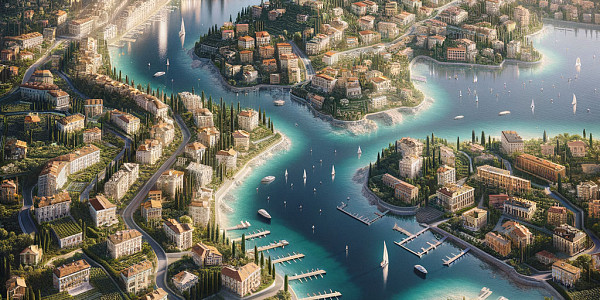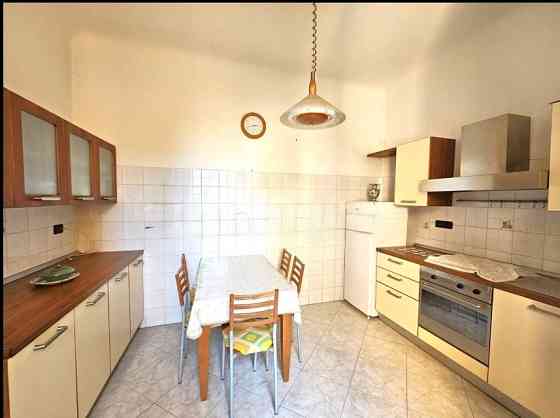
House prices in Italy in 2025 — analyzing regional differences and market prospects
Italy's real estate market has always been characterized by significant regional differences due to economic, social and geographic factors. As of February 2025, these differences continue to shape the landscape of the Italian housing market, creating unique opportunities and challenges for investors and buyers. In this article, we will take an in-depth look at the current market situation, analyze prices in different regions, and provide forecasts for future developments.
Regional differences in house purchase prices
One of the main features of the Italian real estate market is a significant price gap between the northern and southern regions of the country.
- Northern regions:
— Trentino-Alto Adige leads the way in terms of housing costs, where the average price per square meter reaches 3,482 euros. This region attracts buyers with its developed economy, high standard of living and picturesque mountain scenery.
— Valle d'Aosta and Liguria are also characterized by high prices — 2,843 and 2,690 euros per square meter respectively. These regions are popular with wealthy buyers due to their location in the Alps and on the coast of the Ligurian Sea.
— Lombardy, the economic center of Italy, offers housing at an average of 2,519 euros per sq.m. The high demand here is due to the availability of jobs and developed infrastructure. - Central regions:
— Lazio, where the capital Rome is located, is the most expensive in the central part of Italy. The average price per square meter here is 2,490 euros.
— Tuscany, known for its picturesque landscapes and cultural heritage, attracts real estate buyers at an average price of 2,508 euros per square meter.
— In Emilia-Romagna and Marche, prices are more moderate — 2,027 and 1,632 euros per square meter, respectively. - Southern regions:
— Calabria remains the most affordable region in Italy with an average price of €951 per square meter. Low prices here are associated with a less developed economy and infrastructure.
— In Campania and Puglia average prices are 1911 and 1422 euros per square meter. These regions are gradually gaining popularity among buyers attracted by the favorable climate and the beauty of the coast.
— Sicily and Sardinia offer housing at 1161 and 2378 euros per square meter, respectively. Although these islands are famous for their beaches and nature, prices here are constrained by the distance from the continent.
Regional differences in rental rates
Rental rates in Italy also vary significantly by region.
- Northern regions:
— Lombardy leads the way in rental costs with an average price of €18.35 per square meter per month. The high demand for rentals in Milan and other major cities in the region is due to their economic activity and labor influx.
— Valle d'Aosta is also characterized by high rental rates at €18.17 per sqm per month, due to the region's popularity with tourists and limited housing supply. - Central regions:
— In Lazio, the average rental rate is 14.29 euros per square meter per month. Prices here are influenced by the high demand for housing in Rome from both locals and numerous tourists and expats.
— Tuscany offers rents at an average price of €15.18 per square meter per month. The region's popularity with foreigners and the limited supply of housing in historic city centers contribute to the high rates. - Southern regions:
— Calabria is the most affordable region for rentals as well, with an average price of €6.7 per square meter per month. Low demand and oversupply are due to the economic problems of the region and the outflow of population.
— In Molise and Basilicata, average rental rates are also relatively low at €7.09 and €7.43 per sqm per month respectively. These sparsely populated regions are not yet in great demand among tenants.
Factors affecting the Italian real estate market
Price dynamics in the Italian housing market is influenced by a number of factors:
- The economic situation in the country and regions. The more developed northern and central regions with diversified economies tend to show higher real estate prices. Southern regions with high unemployment and dependence on government subsidies are characterized by lower prices.
- Tourism and popularity with foreign buyers. Regions favored by tourists and foreign investors (Tuscany, Liguria, Sardinia, etc.) tend to have higher prices, especially in the segment of luxury housing.
- Demographic trends and urbanization. Population migration to large cities and more developed regions leads to an increase in demand and prices for housing in these areas. On the other hand, the outflow of population from economically weak regions such as Calabria and Basilicata contributes to lower prices and low liquidity of real estate.
- State of infrastructure and transportation accessibility. Regions with developed infrastructure, such as Lombardy and Emilia-Romagna, attract more investors and buyers, which positively affects prices. The underdeveloped southern regions, on the other hand, suffer from a lack of investment and low demand.
- Public policy and taxation. Changes in tax legislation and government programs to support homebuyers can have a significant impact on market dynamics. For example, the introduction of tax incentives for first-time homebuyers can stimulate demand and price growth.
Install our app and get all the tools you need to search for real estate abroad in your smartphone! The mobile application will allow you to quickly access your personal account, manage your favorite properties and track your requests, directly exchange messages with sellers and buyers.

Forecasts for the development of the Italian real estate market
The future development of the Italian housing market will be determined by a combination of economic, demographic and political factors. Here are some key trends that could affect the market in the coming years:
- Gradual narrowing of the North-South gap. As the Italian economy recovers from the pandemic and investment flows to the southern regions, the North-South gap in real estate prices may begin to narrow. However, this process will be gradual and will require significant infrastructure development and job creation in the South.
- Increased demand for housing in small towns and rural areas. The COVID-19 pandemic has intensified buyers' interest in real estate outside major cities, where it is possible to combine a comfortable life with the possibility of remote work. This trend may lead to an increase in prices in some small towns and rural areas, especially those with good transportation accessibility and infrastructure.
- Increased investment in energy efficiency and environmentally friendly housing. As attention to climate change and sustainability issues increases, more buyers will favor energy efficient and environmentally friendly homes. This could lead to higher prices for properties that meet modern energy efficiency and environmental standards, especially in the northern and central regions of Italy.
- Impact of economic and political risks. The dynamics of the Italian real estate market will largely depend on the overall economic and political situation in the country. Factors such as rising public debt, political instability or new economic crises could negatively affect demand and house prices throughout Italy. At the same time, effective measures to stimulate the economy and attract investment could support the market and contribute to price growth in the long term.
Conclusion
The Italian real estate market is a complex mosaic where regional differences in house prices are determined by a range of economic, social and geographical factors. While the North-South gap remains significant, gradual changes in the Italian economy and society may lead to a more balanced market in the future. For buyers and investors, a thorough analysis of local market conditions and trends is key. Understanding the specifics of each region, its economic outlook and demographic trends will help make informed decisions and maximize the benefits of investing in Italian real estate.
Despite the challenges and risks, the Italian housing market remains attractive to many buyers due to the country's rich cultural heritage, high quality of life and potential for growth in the long term. With the right approach and careful choice of region and type of real estate investment in housing in Italy can be a reliable way to preserve and increase capital.
In conclusion, it is worth noting that this overview is based on current trends and forecasts available as of February 2025. Given the dynamic nature of the real estate market, it is always important to keep up with the latest developments and adjust your strategy according to changing conditions. Regular monitoring of economic indicators, political decisions and local market trends will help investors and buyers make informed decisions.
Average prices by region
To better understand market trends, it is important to look at average real estate prices by region:
| Region | Purchase (€/m²) | Rent (€/m²) |
| Abruzzo | 1 365 | 7,92 |
| Basilicata | 1 353 | 7,43 |
| Calabria | 951 | 6,7 |
| Campania | 1 911 | 10,19 |
| Emilia-Romagna | 2 027 | 13,16 |
| Friuli-Venezia Giulia | 1 624 | 10,05 |
| Lazio | 2 490 | 14,29 |
| Liguria | 2 690 | 10,82 |
| Lombardy | 2 519 | 18,35 |
| Marche | 1 632 | 9 |
| Molise | 1 069 | 7,09 |
| Piedmont | 1 394 | 9,69 |
| Puglia | 1 422 | 8,49 |
| Sardinia | 2 378 | 13,48 |
| Sicily | 1 161 | 7,68 |
| Tuscany | 2 508 | 15,18 |
| Trentino-Alto Adige | 3 482 | 12,91 |
| Umbria | 1 158 | 7,73 |
| Valle d'Aosta | 2 843 | 18,17 |
| Veneto | 2 035 | 11,68 |
 Real Estate in Italy
Real Estate in Italy
 12
12
 10
10
 6
6
 11
11
 101
101  3
3  2
2  1
1  6
6 
A detailed review of the current situation in the Italian real estate market as of February 2025. Analyzes regional differences in the prices for buying and renting housing, considers the factors affecting the market, and provides forecasts for further development by region.

Northern Italy continues to set trends in the country's real estate market, demonstrating high rates of growth in housing prices. The region's economic stability, rich cultural heritage and natural beauty attract both locals and foreign investors. But rising housing prices can create difficulties for local residents.


























